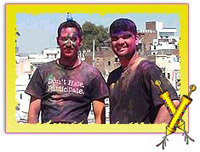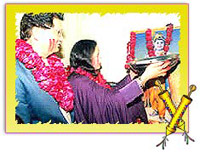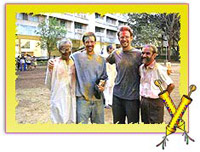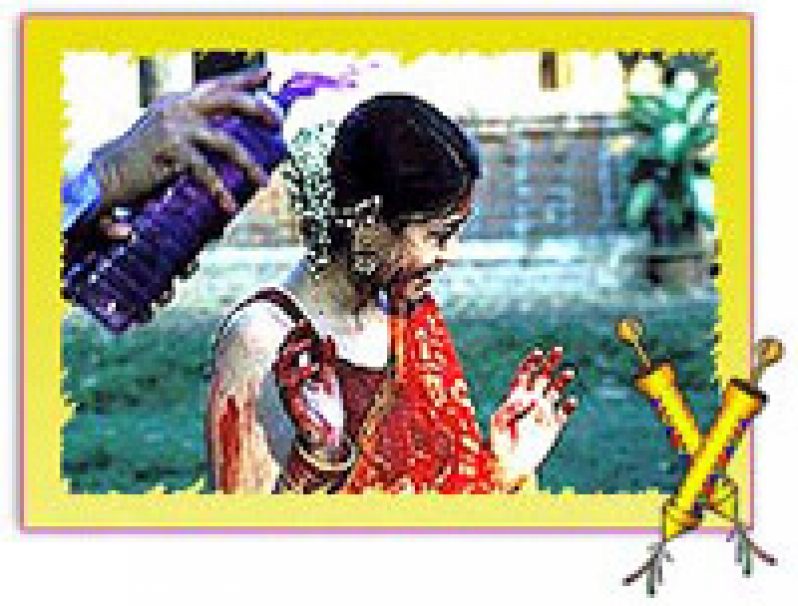Holi knows no bars, Holi knows no boundaries too. Across the world wherever Indians or people of Indian origin are present Holi is celebrated with gusto and bonhomie. People play with colours, light a bonfire called Holika and celebrate the victory of good over evil.
Well, the essence of any festival is to take a break from the daily humdrum of life and make it interesting. The other major intention of celebrating festival is to bring people together and generate a feeling of brotherhood and spread harmony all around.
Nobody realizes the importance of celebrating festivals than the Indians settled abroad away from their country and cultural roots. At times they are more eager to celebrate festivals than their Indian counterparts. For celebrating festivals is what binds the people of Indian origin together and also to their roots.
Just as in India, people settled abroad meet their friends and exchange sweets and greetings. Of course, the revelry is no less when it comes to colours.
Holi in Bangladesh
Bengal region has a multifaceted culture due to the influence of Buddhist, Hindus and Muslim cultures. Though the country is Muslim dominated, Hindus too celebrate their festivals with gaiety.
Of course, the pomp and show of Holi as witnessed in India is missing, nevertheless, celebrations do take place. Hindu community gather in temples and exchange greetings with each other and play with colours.
Indian culture has influenced Bangladesh a lot as the country is nestled in the crook of the Bay of Bengal and is surrounded by India. It shares a border in the south-east with Myanmar and fronts onto the Bay of Bengal. The country is flat and dominated by the braided strands of the Ganges-Brahmaputra-Jamuna delta. Bangladesh’s Muslims and Hindus live in relative harmony.
Holi in Mauritius
Just as the many other major Hindu festivals, the large Indian majority, (about 63 per cent) celebrate Holi with a lot of enthusiasm in the island of Mauritius.
It is an official holiday in the country and therefore people get all the time to make merry and drench themselves in the spirit of Holi and of course, colour water.
Hindus, here duly perform the tradition of Holika Dahan or lighting of bonfire on the eve of Holi and celebrate the victory of good over evil. Next day people revel and play with colours and drench everybody with water jets called pichkaris. While in the evening they greet each other with tilak and exchange sweets.
Holi is also marked as a Spring Festival when the nature wears its best clothes and fields and flowers are in full bloom.
Holi in Nepal
Holi is celebrated with great pomp and show in Nepal. Celebrations lasts for a week in which the entire country gets drenched in the coloured water.
Celebrations are of marked importance at Terai and also where Indian community mainly Marwaris have settled. Families and friends get together and celebrate the occasion with a lot of merry making.
All over the streets people can be watched having fun, throwing colours and water-balloons, locally called ‘lolas’ on each other.
Though play of colours takes place on the last day, a ceremonial pole called, ‘chir’ is installed on the first day. Chir is a bamboo pole fringed with strips of clothes representing good luck charms. As the pole is put up in the street at Basantapur, the festivities and worship commences for the week. At the end of the festivities chir is taken to a bonfire.
There is a popular legend behind the installation of chir. The story is again about the mischievous nature of Krishna who just loved to pray pranks with the milkmaids or gopis. Playful as he was, it is said that once he seduced all the local girls with his dashing good looks. He then danced with them all and when they fully engrossed in him, then he thought they were ripe for a tease. He doused them in coloured water and stole all their clothes while they were bathing in the water of river Yamuna. Naughty Krishna then hung their clothes on a tree to bug them. Chir symbolizes that very tree.
The other legends popular in India as that of Prahlad and his devilish father, Hiranyakashyap. Hiranyakashyap asked his sister, Holika to enter a blazing fire with Prahlad in her lap. However, Prahlad was saved for his extreme devotion by Lord Vishnu while Holika paid a price for her sinister desires. Every year just as in India people in Nepal light a bonfire- called Holika to mark the victory of good over evil.
Also known is the legend of Pootana who tried to kill infant Krishna by feeding her poisonous milk on the direction of devil hearted uncle of Krishna called Kansa.
Holi in Pakistan
Hindus residing in Pakistan also celebrate holi, though, of course, in not as grand a fashion as seen in India.
People celebrate the victory of good over evil forces by lighting bonfires called Holika. The tradition comes from the legend of Prahlad and Hiranyakashyap. In fact, people follow the same traditions and rituals as in India due to their roots in India. People clean their houses and prepare special delicacies like gujiyas, papri and dahi badas. They meet up with friends and play with the colours, dance and generally have good time. Hindus usually gather in temples and celebrate the Holi there. Much gaiety can be seen in temples located in cities which have a comparatively greater Hindu population. Such as in Lahore and Sindh region.
Holi in South Africa
Indians wherever they may be, takes immense delight in celebrating the festival of Holi and South Africa is no exception. The vibrant Gujarati’s and other Indians settled in South Africa have made it a point to keep the tradition of celebrating Holi alive in the country. They play colours, light bonfires called Holika, sing Holi songs and make merry. The evenings are spent in meeting friends and relatives and exchanging greetings and sweets.
People believe that it is becoming all the more important to keep the ancient customs alive in this conflict ridden society. The festival of Holi is vital in this aspect as it is believed that Holi helps people to get closer. It generates warmth in relationships and even enemies turns friends in the spirit of Holi.
It may be noted that South Africa is located at the southern tip of the continent of Africa.
It had the largest immigrant Indian community in the world a decade prior to the colonization by the United States of America. Indians account of almost one million in the country. Most of them are concentrated in the eastern regions of Natal and Transvaal of the country. About 65% are Hindus, 15% Muslims and 20% of Christians live in this area. Due to the majority of the Hindu population, a number of Hindu festivals are celebrated here. Most of the Hindus here are from Uttar Pradesh, Gujarat and Tamil Nadu and continue to follow their regional variations of Hinduism.
Holi in Suriname
Holi is celebrated with lot of mirth and excitement in Surinam which has a large number of Indians. Hindus constitute about 35-40% of the population, an important part of this is people who immigrated from Uttar Pradesh and Bihar.
Just as in India, people here take great delight in spraying colour on each other and singing Holi songs. Holika is also burnt on the eve of Holi which is symbolic of victory of good over evil.
There is a similarity in the way Holi is celebrated in Surinam and that in Guyana and Trinidad and Tobago. Here too, people plant a castor oil plant weeks before the festival and this plant is burnt later as Holika. Between these days people engage themselves in nightly chowtaal and taan singing at each other’s homes or at the temples.
Delicacies like bara, gulgula, phulourie, bigany, mango or tamarind chutney, potato ball, prasad, channa, ghoja, mahambhoog, kheer or sweet rice, among others beverage are prepared and served at the temples where large Holi gatherings takes place.
Trinidad and Tobago
Holi is celebrated with a lot of pomp and eclat in twin island states of Trinidad and Tobago which has a large Indian diaspora. Here, it is largely known as Phagwa.
Holi is said to have come to Trinidad around 1845 by the Hindus who migrated from Bihar as contractual labourers on the sugarcane field. Since then it is being celebrated every year with great enthusiasm.
In the early days the festival was observed very modestly because of the many constraints that the Hindus had to deal with. But, today it is celebrated at a national level, in a grand style throughout Trinidad.
Just as their Indian counterparts, Hindus in Trinidad and Tobago celebrate the festival with colours, songs, music and dance. A variety of water colours are mixed and sprayed on all those who participate in the celebrations, till they become unrecognizable. People exchange sweets and greetings with each other. Hard feelings or animosity, if any, are also washed down with the coloured waters of Holi and general harmony prevails.
A special type of folk song called Chowtal is sung during the course of the festival and the music is usually played with only two instruments. The dholak (a hand drum) and the majeera (cymbals or percussion instrument) are the only two instruments used. Chowtal songs are sung rather loudly and are high pitched. Fast paced music invites people to shake their hips and sway with the rhythm.
Holi in United Kingdom
Hindus settled in UK do not miss out the excitement of Holi celebrations and enjoy to the hilt. Zeal for the festival is particularly marked in this country as Indians constitute the second largest ethnic minority. Celebrating festivals help them to feel close to their families and cultural roots.
The celebration of Holi is noticeable at places that witness a large congregation of Indians. The British city of Leicester is particularly known for its love for celebrating Indian festivals. Excitement reaches its peak when the occasion is that of celebrating a joyous festival like Holi.
Children love to use their spray cans and colour each other. Holi parades are also carried and in the evening people visit their friends and relatives to exchange greetings and sweets. They hug each other and also apply the tilak as the meet Holi in a traditional manner.
Holi in USA
With a large population of Indians settled in the United States of America, Holi is celebrated with gaiety and lot of fanfare in this country.
Different societies formed by the Indians and religious organisations help people to celebrate this joyous festival and feel close to their cultural roots. Music programmes and Holi Meets are also organised by them to mark the occasion. These meets help the new generation to identify with their cultural root. Children learn to understand the significance of celebrating festivals and know legends asociated with them.
Great enthusiasm for the festival can be specially witnessed in cities where large number of Indians have settled. Holi celebrations are particularly marked in the city of New York.
Here Holi parades are taken out. People can be seen having so much fun in these parades as they play with the colour in the midst. There is so much revelry here that it becomes difficult to imagine that New York is not a part of India.
Bollywood actors also take time out to celebrate Holi with the people of USA doubling the excitement for the festival. Dance performance, fashion shows and music concerts further add to the festive spirit.




.png)









